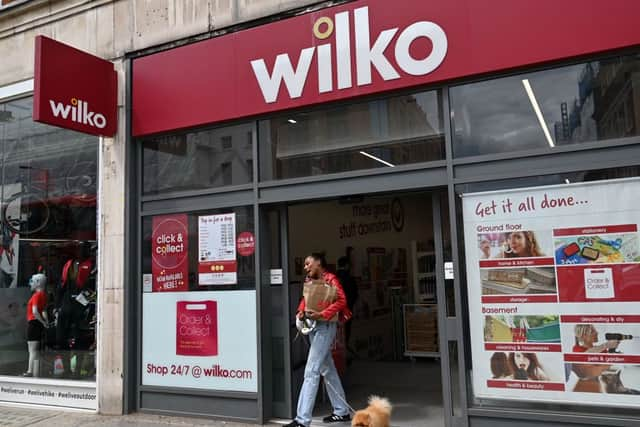Wilko administration: what does going into administration mean? Business process explained
and live on Freeview channel 276
Every year, thousands of UK businesses go into administration. Indeed, official figures from public body the Insolvency Service released in July showed the number of company failures hit a 14-year high in the three months to June 2023, with 6,342 collapses recorded.
It comes after 22,109 firms shut their doors in 2022 - a 57% year-on-year increase. Higher interest rates, steep increases in energy bills and labour costs, as well as lower consumer spending in the face of the cost of living crisis have all heightened the financial stress companies are under.
While most insolvencies involve smaller firms, we tend to see several household names suffer this fate every year. These collapses often put thousands of jobs at risk. The biggest names to have found themselves in this position of late have been parcel delivery giant Tuffnells, stationary chain Paperchase and online furniture retailer Made. Major cinema chain Cineworld is also going through the process, with more than 100 of its theatres across the UK - as well as some of its Picturehouse venues - facing potential closure.
The latest big name firm to go under is high street retailer Wilko. The value-oriented store chain has been in difficulty for several months, with the latest development putting 12,000 job roles under threat.
But what exactly does it mean when a company goes into administration - and what can it mean for consumers? Here’s what you need to know.
What does administration mean?
‘Going into administration’ is a business term for when a company can’t meet its financial obligations to its lenders - insolvency - and has to call in administrators.
Administrators, who are sometimes known as insolvency practitioners, take over the running of the company from its executives and must hold a licence to perform the role. They either work towards saving the business, or carve it up so creditors are paid at least some of the money they’re owed.


Basically, while administration creates a lot of uncertainty for those who work for the firm as well as its customers, it does not necessarily mean it’s the end for the company in question. What the administrators work towards achieving depends on whether the company is viable or not.
There is also a different sort of administration known as a ‘pre-pack administration’. This type tends to be used in instances where a company’s principal value relates to a brand it owns - the value of which would likely be severely dented should the company go into full administration.
Not only would this reduce the chances of the firm being rescued, but it could also hit creditors in the pocket. A pre-pack essentially allows the company to line up a full or partial sale with the help of an administrator before the company formally goes into administration.
How does administration work?
When a company first goes into administration, it gets a statutory moratorium - essentially, it is granted legal breathing space from the creditors (including banks, suppliers and customers) who are chasing up their money.
Administrators use this period to put together plans for how to financially restructure the business to keep it running, and may keep day-to-day operations running as usual. They might also put the company in a shop window to encourage other businesses to buy up the business.
Should they find a way to keep the firm going, the insolvency practitioners will eventually hand control of the company back to its directors and some jobs will be saved. If, however, the firm is in too dire a situation to rescue as a whole entity, the administrator’s focus will turn to hiving off parts of the business with the aim of giving its creditors the best return possible. This process can involve the sale of the company’s assets, like equipment, software or customer databases, or of its divisions or brands.
The administrators can also opt to entirely liquidate the business - i.e. close its doors and sell everything the business owns - to generate money. When this happens the proceeds go to secured (i.e. insured) or preferential creditors (usually employees) in the first instance.


In the UK, administrators have eight weeks to put plans together for either of these three options and then must present them to the firm’s creditors, who then get to vote on them. Overall, the administration process can take a maximum of 12 months to complete - unless the administrator is granted an extension by a court or creditors.
Where does administration money go?
Should administrators opt for a full or partial sale or a liquidation, the money will go to the company’s creditors. There is a pecking order for who receives the money they are owed first. Generally it is:
- Secured creditors (e.g. banks who have provided mortgages or loans)
- Preferential creditors (HMRC for unpaid taxes and employees who are owed wages, holiday pay and pension contributions)
- Unsecured creditors (suppliers and customers)
- Shareholders or members
So, if you’re a customer of a business, you might not be guaranteed a full or even a partial refund if that business collapses because the money generated by any sale or liquidation is likely to go towards those in the top two categories. In the case of Cineworld, if the chain goes into administration and is carved up, you may never recoup any money stored on a gift card or in the form of credit - e.g. a monthly cinema pass.
Comment Guidelines
National World encourages reader discussion on our stories. User feedback, insights and back-and-forth exchanges add a rich layer of context to reporting. Please review our Community Guidelines before commenting.
